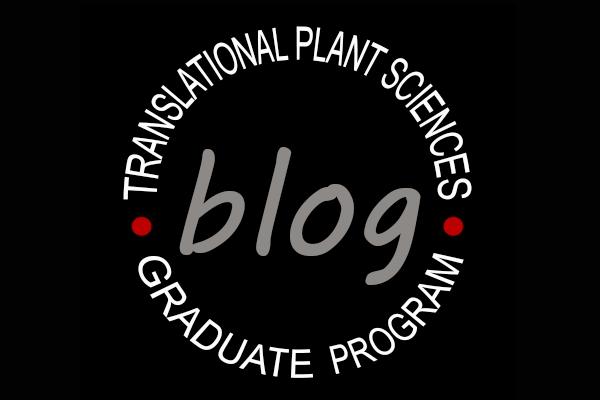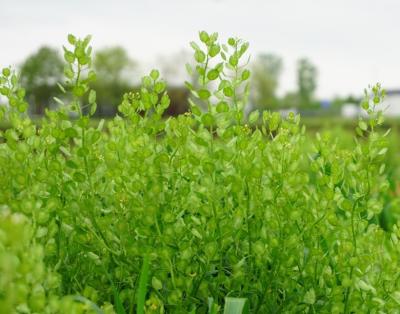Pennycress: The weed picking up speed


A new biofuel cover crop is on the horizon for farmers in the Midwest. Field pennycress is a winter annual with extreme cold tolerance, making it an excellent candidate for a winter cover crop that can be grown on fallow fields following corn and soybean harvest. Pennycress, or Thlaspi arvense, gets its name from the penny-like shape of its seed pods. The seeds within these pods have a high oil content and a favorable lipid profile that meet the U.S. renewable fuels standard when converted to biofuel. While providing all the benefits of a cover crop, pennycress seed can be harvested in the early summer and provide farmers with an additional source of revenue in the form of biofuel and animal feed. Pennycress also provides several ecosystem benefits, such as the prevention of nutrient leaching, soil erosion, and spring weed growth, as well as serving as a food source for native pollinators1,2.
Within the last few years, researchers have successfully been able to target specific genes to eliminate weedy properties and make the seed oil and protein more nutritional. This rapid domestication of pennycress was enabled by several factors. As a member of the Brassicaceae family, pennycress is closely related to the model organism Arabidopsis thaliana and other popular oilseed crops such as canola and camelina. The vast data and resources available for Arabidopsis and these other oilseeds are easily translatable to pennycress. Pennycress also has a sequenced draft genome and transcriptome3,4. Combining these resources has allowed researchers to quickly examine and identify important genes for domestication.
The genes that have been recently targeted are mostly related to the improvement of various seed traits. For instance, a gene involved in the production of erucic acid in the seed oil has been targeted using CRISPR/Cas9 to knock-out the gene to abolish erucic acid, therefore creating an edible seed oil5. Gene editing and chemical mutagenesis has allowed several other domestication traits to be selected for, such as reduced pod shatter, increased oil and protein content, and reduced glucosinolate content. These traits are important for preventing yield loss and for making the pennycress seed more palatable for use as animal feed or as a potential source of protein for humans. However, work is still being done to improve other traits, such as better stand establishment and germination rates, earlier flowering, and improved cold, drought, and flooding tolerance. The development of current elite pennycress lines is mostly a result of traditional mutation breeding and targeted gene editing, however, as newer technologies and approaches emerge along with the generation of more sequencing data, pennycress will continue on this path of rapid domestication.
Renewable jet fuel produced from pennycress could reduce greenhouse gas emission life cycles by 50% in comparison to petroleum, making pennycress an excellent biofuel candidate6. Commercial pennycress seed yields are over 1680 kg ha-1, which produces ~65 gallons of oil per acre, and some wild pennycress varieties can produce up to 2,200 kg ha-1 which is the equivalent of ~85 gallons per acre6,7. If incorporated onto half of the US Midwest Corn Belt, pennycress could fix 40 Mt of carbon annually which is the equivalent of the emissions from ~31 million automobiles6,8. Beginning next fall of 2022, a commercial pennycress company called CoverCress, Inc. is planning to have its first roll out of pennycress varieties to farmers across Illinois, proving its strong potential as an emerging cover crop.
Written by TPS student Rachel Combs-Giroir
References
1Sharon Weyers et al., “Reduced Potential for Nitrogen Loss in Cover Crop–Soybean Relay Systems in a Cold Climate,” Journal of Environmental Quality 48, no. 3 (2019): 660–69, https://doi.org/10.2134/jeq2018.09.0350.
2Carrie A. Eberle et al., “Using Pennycress, Camelina, and Canola Cash Cover Crops to Provision Pollinators,” Industrial Crops and Products, Advances in Industrial Crops and Products Worldwide: AAIC 2014 international conference, 75 (November 30, 2015): 20–25, https://doi.org/10.1016/j.indcrop.2015.06.026.
3 Kevin M. Dorn et al., “De Novo Assembly of the Pennycress (Thlaspi Arvense) Transcriptome Provides Tools for the Development of a Winter Cover Crop and Biodiesel Feedstock,” The Plant Journal 75, no. 6 (2013): 1028–38, https://doi.org/10.1111/tpj.12267.
4 Kevin M. Dorn et al., “A Draft Genome of Field Pennycress (Thlaspi Arvense) Provides Tools for the Domestication of a New Winter Biofuel Crop,” DNA Research 22, no. 2 (April 1, 2015): 121–31, https://doi.org/10.1093/dnares/dsu045.
5 Michaela McGinn et al., “Molecular Tools Enabling Pennycress (Thlaspi Arvense) as a Model Plant and Oilseed Cash Cover Crop,” Plant Biotechnology Journal 17, no. 4 (2019): 776–88, https://doi.org/10.1111/pbi.13014.
6 Jiqing Fan et al., “A Life Cycle Assessment of Pennycress (Thlaspi Arvense L.) -Derived Jet Fuel and Diesel,” Biomass and Bioenergy 55 (August 2013): 87–100, https://doi.org/10.1016/j.biombioe.2012.12.040.
7 Larry W. Mitich, “Field Pennycress (Thlaspi Arvense L.)—The Stinkweed,” Weed Technology 10, no. 3 (September 1996): 675–78, https://doi.org/10.1017/S0890037X00040604.
8 John C Sedbrook and Timothy P Durrett, “Pennycress, Carbon Wise: Labeling Experiments Reveal How Pennycress Seeds Efficiently Incorporate Carbon into Biomass,” Journal of Experimental Botany 71, no. 10 (May 30, 2020): 2842–46, https://doi.org/10.1093/jxb/eraa136.
